Strategic Marketing: Analysis of DB Breweries Brewtroleum Campaign
VerifiedAdded on 2023/06/12
|8
|2181
|412
Report
AI Summary
This report provides a strategic marketing analysis of DB Breweries' Brewtroleum campaign, which won a Grand Effie award for its innovative approach to creating biofuel from beer brewing byproducts. The report includes a PEST analysis, identifying political, economic, social, and technological factors affecting the company. It highlights problems such as negative stakeholder feedback regarding responsible consumption and environmental concerns, particularly water usage and waste management. Opportunities are identified for reducing water consumption, improving waste treatment, promoting responsible drinking, and enhancing community partnerships. The report concludes that DB Breweries has the potential to improve its sustainability efforts, expand its business globally, and build a stronger brand image through strategic initiatives and global partnerships. Desklib provides similar assignments and study tools for students.
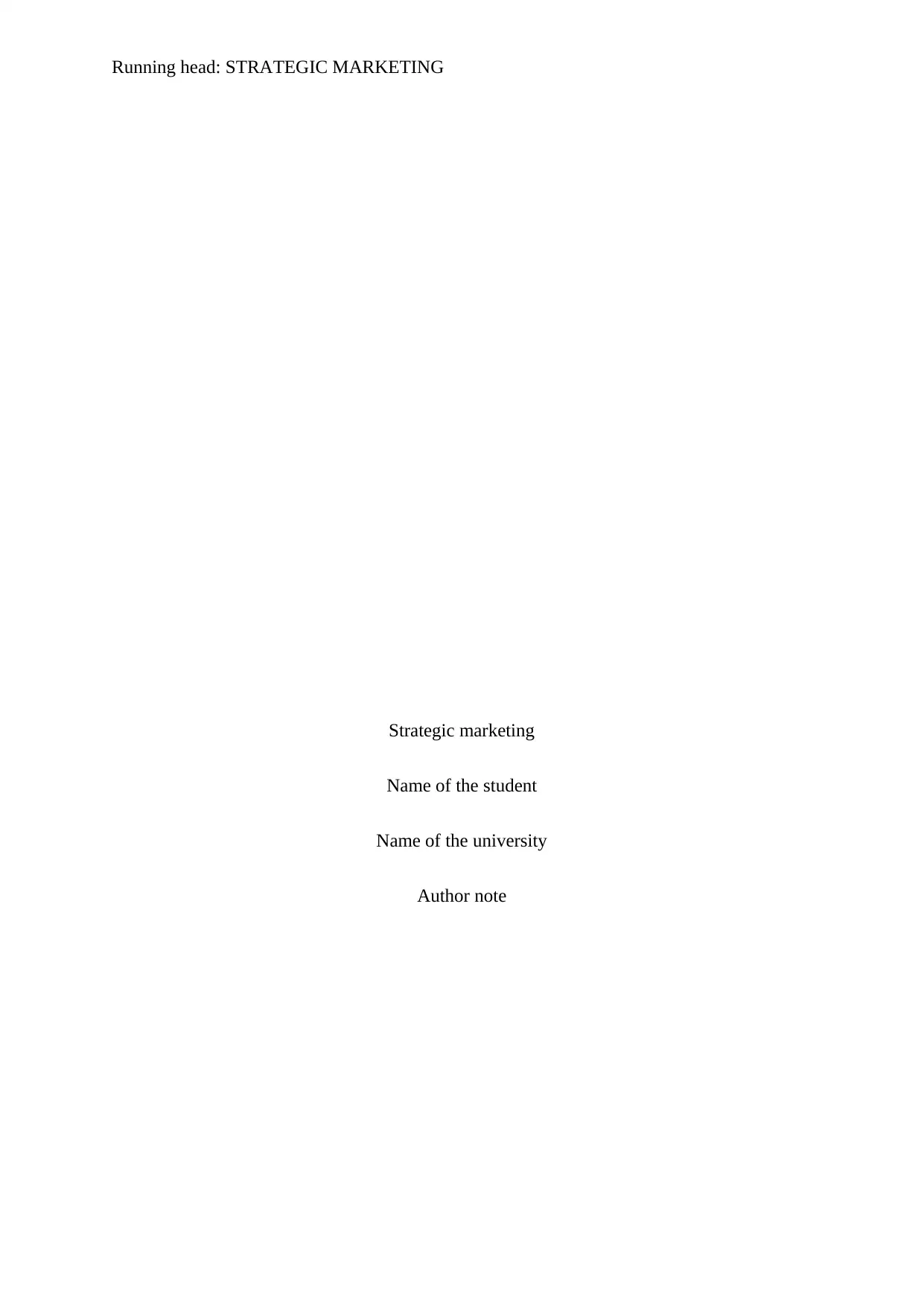
Running head: STRATEGIC MARKETING
Strategic marketing
Name of the student
Name of the university
Author note
Strategic marketing
Name of the student
Name of the university
Author note
Paraphrase This Document
Need a fresh take? Get an instant paraphrase of this document with our AI Paraphraser
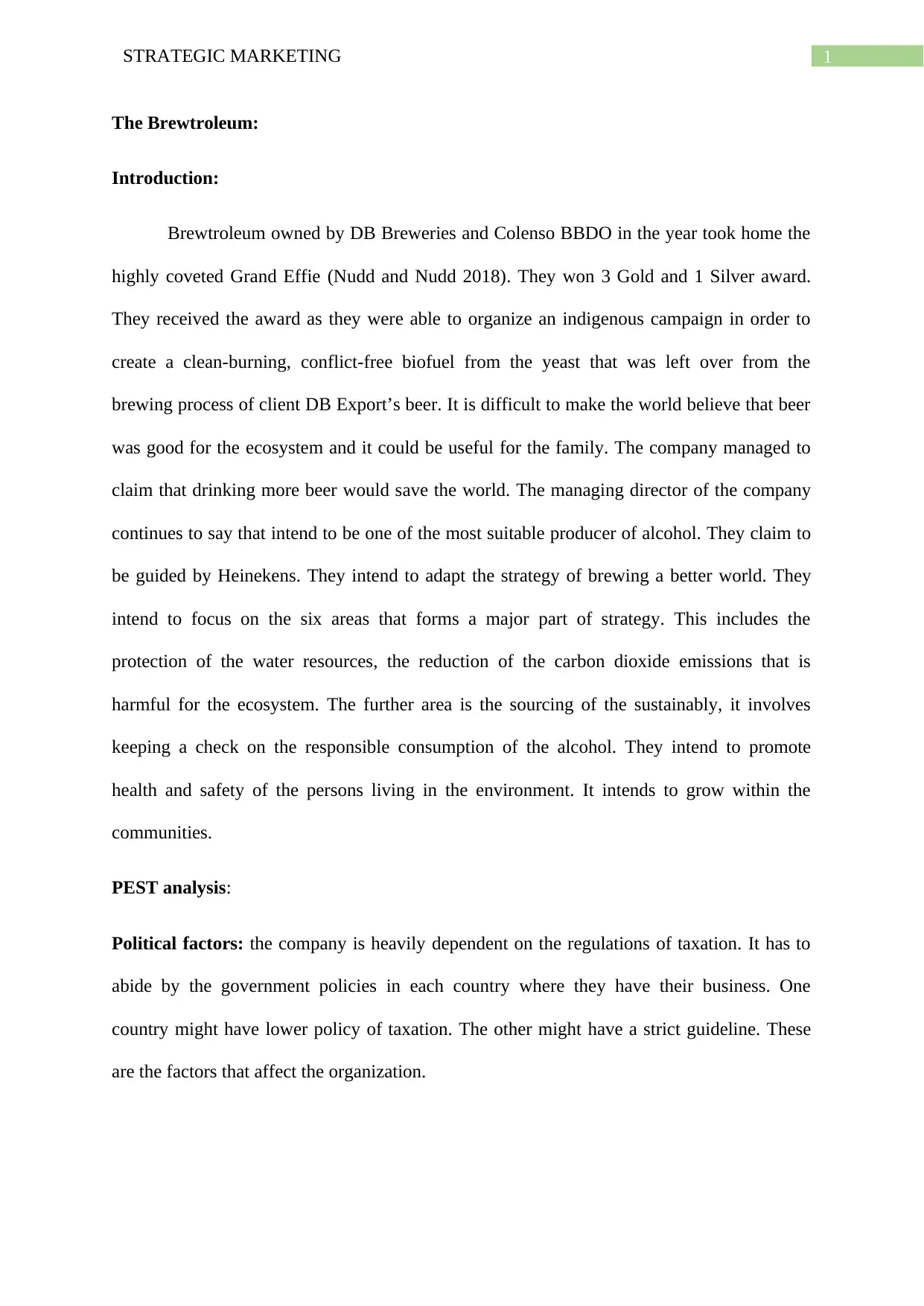
1STRATEGIC MARKETING
The Brewtroleum:
Introduction:
Brewtroleum owned by DB Breweries and Colenso BBDO in the year took home the
highly coveted Grand Effie (Nudd and Nudd 2018). They won 3 Gold and 1 Silver award.
They received the award as they were able to organize an indigenous campaign in order to
create a clean-burning, conflict-free biofuel from the yeast that was left over from the
brewing process of client DB Export’s beer. It is difficult to make the world believe that beer
was good for the ecosystem and it could be useful for the family. The company managed to
claim that drinking more beer would save the world. The managing director of the company
continues to say that intend to be one of the most suitable producer of alcohol. They claim to
be guided by Heinekens. They intend to adapt the strategy of brewing a better world. They
intend to focus on the six areas that forms a major part of strategy. This includes the
protection of the water resources, the reduction of the carbon dioxide emissions that is
harmful for the ecosystem. The further area is the sourcing of the sustainably, it involves
keeping a check on the responsible consumption of the alcohol. They intend to promote
health and safety of the persons living in the environment. It intends to grow within the
communities.
PEST analysis:
Political factors: the company is heavily dependent on the regulations of taxation. It has to
abide by the government policies in each country where they have their business. One
country might have lower policy of taxation. The other might have a strict guideline. These
are the factors that affect the organization.
The Brewtroleum:
Introduction:
Brewtroleum owned by DB Breweries and Colenso BBDO in the year took home the
highly coveted Grand Effie (Nudd and Nudd 2018). They won 3 Gold and 1 Silver award.
They received the award as they were able to organize an indigenous campaign in order to
create a clean-burning, conflict-free biofuel from the yeast that was left over from the
brewing process of client DB Export’s beer. It is difficult to make the world believe that beer
was good for the ecosystem and it could be useful for the family. The company managed to
claim that drinking more beer would save the world. The managing director of the company
continues to say that intend to be one of the most suitable producer of alcohol. They claim to
be guided by Heinekens. They intend to adapt the strategy of brewing a better world. They
intend to focus on the six areas that forms a major part of strategy. This includes the
protection of the water resources, the reduction of the carbon dioxide emissions that is
harmful for the ecosystem. The further area is the sourcing of the sustainably, it involves
keeping a check on the responsible consumption of the alcohol. They intend to promote
health and safety of the persons living in the environment. It intends to grow within the
communities.
PEST analysis:
Political factors: the company is heavily dependent on the regulations of taxation. It has to
abide by the government policies in each country where they have their business. One
country might have lower policy of taxation. The other might have a strict guideline. These
are the factors that affect the organization.
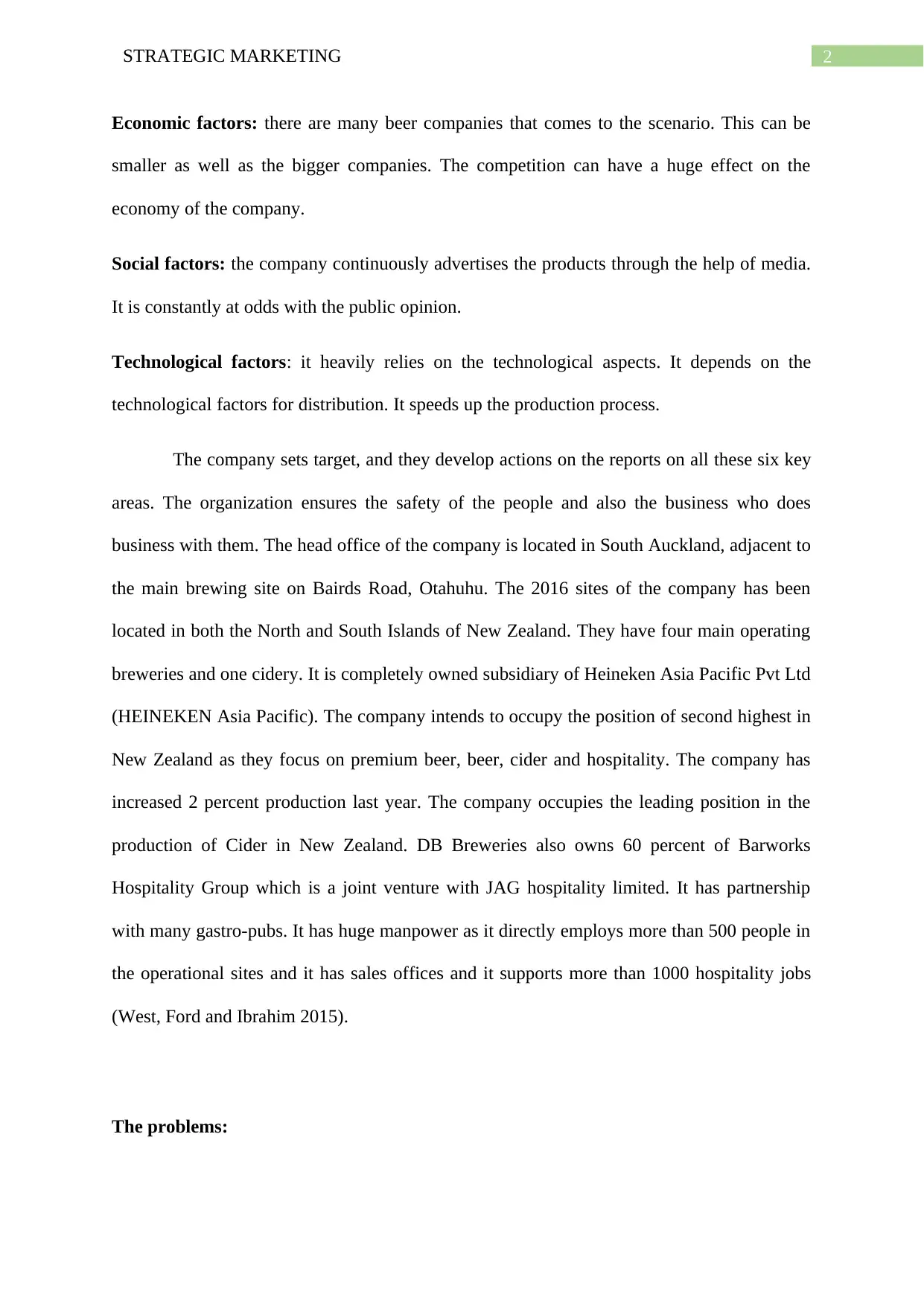
2STRATEGIC MARKETING
Economic factors: there are many beer companies that comes to the scenario. This can be
smaller as well as the bigger companies. The competition can have a huge effect on the
economy of the company.
Social factors: the company continuously advertises the products through the help of media.
It is constantly at odds with the public opinion.
Technological factors: it heavily relies on the technological aspects. It depends on the
technological factors for distribution. It speeds up the production process.
The company sets target, and they develop actions on the reports on all these six key
areas. The organization ensures the safety of the people and also the business who does
business with them. The head office of the company is located in South Auckland, adjacent to
the main brewing site on Bairds Road, Otahuhu. The 2016 sites of the company has been
located in both the North and South Islands of New Zealand. They have four main operating
breweries and one cidery. It is completely owned subsidiary of Heineken Asia Pacific Pvt Ltd
(HEINEKEN Asia Pacific). The company intends to occupy the position of second highest in
New Zealand as they focus on premium beer, beer, cider and hospitality. The company has
increased 2 percent production last year. The company occupies the leading position in the
production of Cider in New Zealand. DB Breweries also owns 60 percent of Barworks
Hospitality Group which is a joint venture with JAG hospitality limited. It has partnership
with many gastro-pubs. It has huge manpower as it directly employs more than 500 people in
the operational sites and it has sales offices and it supports more than 1000 hospitality jobs
(West, Ford and Ibrahim 2015).
The problems:
Economic factors: there are many beer companies that comes to the scenario. This can be
smaller as well as the bigger companies. The competition can have a huge effect on the
economy of the company.
Social factors: the company continuously advertises the products through the help of media.
It is constantly at odds with the public opinion.
Technological factors: it heavily relies on the technological aspects. It depends on the
technological factors for distribution. It speeds up the production process.
The company sets target, and they develop actions on the reports on all these six key
areas. The organization ensures the safety of the people and also the business who does
business with them. The head office of the company is located in South Auckland, adjacent to
the main brewing site on Bairds Road, Otahuhu. The 2016 sites of the company has been
located in both the North and South Islands of New Zealand. They have four main operating
breweries and one cidery. It is completely owned subsidiary of Heineken Asia Pacific Pvt Ltd
(HEINEKEN Asia Pacific). The company intends to occupy the position of second highest in
New Zealand as they focus on premium beer, beer, cider and hospitality. The company has
increased 2 percent production last year. The company occupies the leading position in the
production of Cider in New Zealand. DB Breweries also owns 60 percent of Barworks
Hospitality Group which is a joint venture with JAG hospitality limited. It has partnership
with many gastro-pubs. It has huge manpower as it directly employs more than 500 people in
the operational sites and it has sales offices and it supports more than 1000 hospitality jobs
(West, Ford and Ibrahim 2015).
The problems:
⊘ This is a preview!⊘
Do you want full access?
Subscribe today to unlock all pages.

Trusted by 1+ million students worldwide
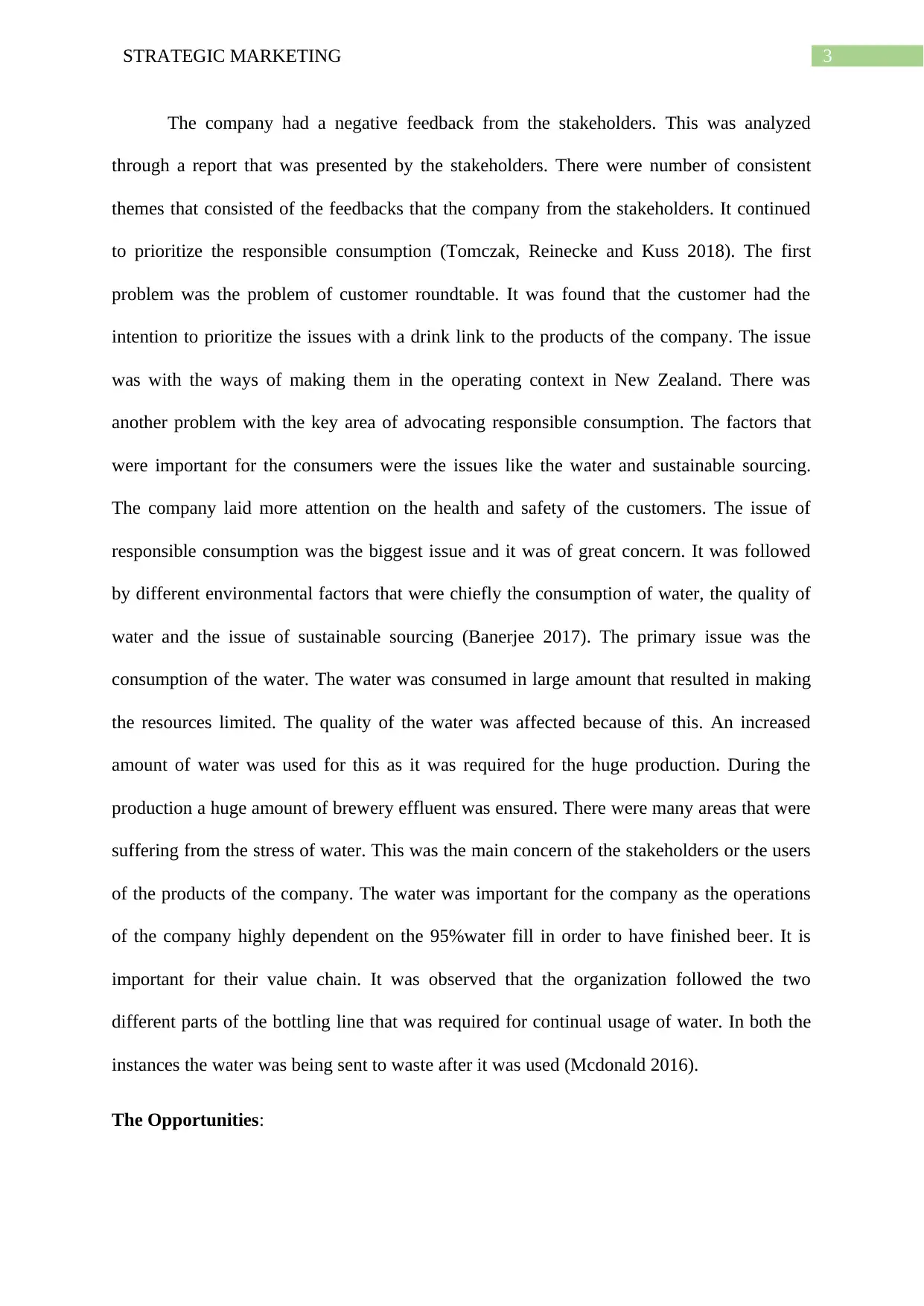
3STRATEGIC MARKETING
The company had a negative feedback from the stakeholders. This was analyzed
through a report that was presented by the stakeholders. There were number of consistent
themes that consisted of the feedbacks that the company from the stakeholders. It continued
to prioritize the responsible consumption (Tomczak, Reinecke and Kuss 2018). The first
problem was the problem of customer roundtable. It was found that the customer had the
intention to prioritize the issues with a drink link to the products of the company. The issue
was with the ways of making them in the operating context in New Zealand. There was
another problem with the key area of advocating responsible consumption. The factors that
were important for the consumers were the issues like the water and sustainable sourcing.
The company laid more attention on the health and safety of the customers. The issue of
responsible consumption was the biggest issue and it was of great concern. It was followed
by different environmental factors that were chiefly the consumption of water, the quality of
water and the issue of sustainable sourcing (Banerjee 2017). The primary issue was the
consumption of the water. The water was consumed in large amount that resulted in making
the resources limited. The quality of the water was affected because of this. An increased
amount of water was used for this as it was required for the huge production. During the
production a huge amount of brewery effluent was ensured. There were many areas that were
suffering from the stress of water. This was the main concern of the stakeholders or the users
of the products of the company. The water was important for the company as the operations
of the company highly dependent on the 95%water fill in order to have finished beer. It is
important for their value chain. It was observed that the organization followed the two
different parts of the bottling line that was required for continual usage of water. In both the
instances the water was being sent to waste after it was used (Mcdonald 2016).
The Opportunities:
The company had a negative feedback from the stakeholders. This was analyzed
through a report that was presented by the stakeholders. There were number of consistent
themes that consisted of the feedbacks that the company from the stakeholders. It continued
to prioritize the responsible consumption (Tomczak, Reinecke and Kuss 2018). The first
problem was the problem of customer roundtable. It was found that the customer had the
intention to prioritize the issues with a drink link to the products of the company. The issue
was with the ways of making them in the operating context in New Zealand. There was
another problem with the key area of advocating responsible consumption. The factors that
were important for the consumers were the issues like the water and sustainable sourcing.
The company laid more attention on the health and safety of the customers. The issue of
responsible consumption was the biggest issue and it was of great concern. It was followed
by different environmental factors that were chiefly the consumption of water, the quality of
water and the issue of sustainable sourcing (Banerjee 2017). The primary issue was the
consumption of the water. The water was consumed in large amount that resulted in making
the resources limited. The quality of the water was affected because of this. An increased
amount of water was used for this as it was required for the huge production. During the
production a huge amount of brewery effluent was ensured. There were many areas that were
suffering from the stress of water. This was the main concern of the stakeholders or the users
of the products of the company. The water was important for the company as the operations
of the company highly dependent on the 95%water fill in order to have finished beer. It is
important for their value chain. It was observed that the organization followed the two
different parts of the bottling line that was required for continual usage of water. In both the
instances the water was being sent to waste after it was used (Mcdonald 2016).
The Opportunities:
Paraphrase This Document
Need a fresh take? Get an instant paraphrase of this document with our AI Paraphraser
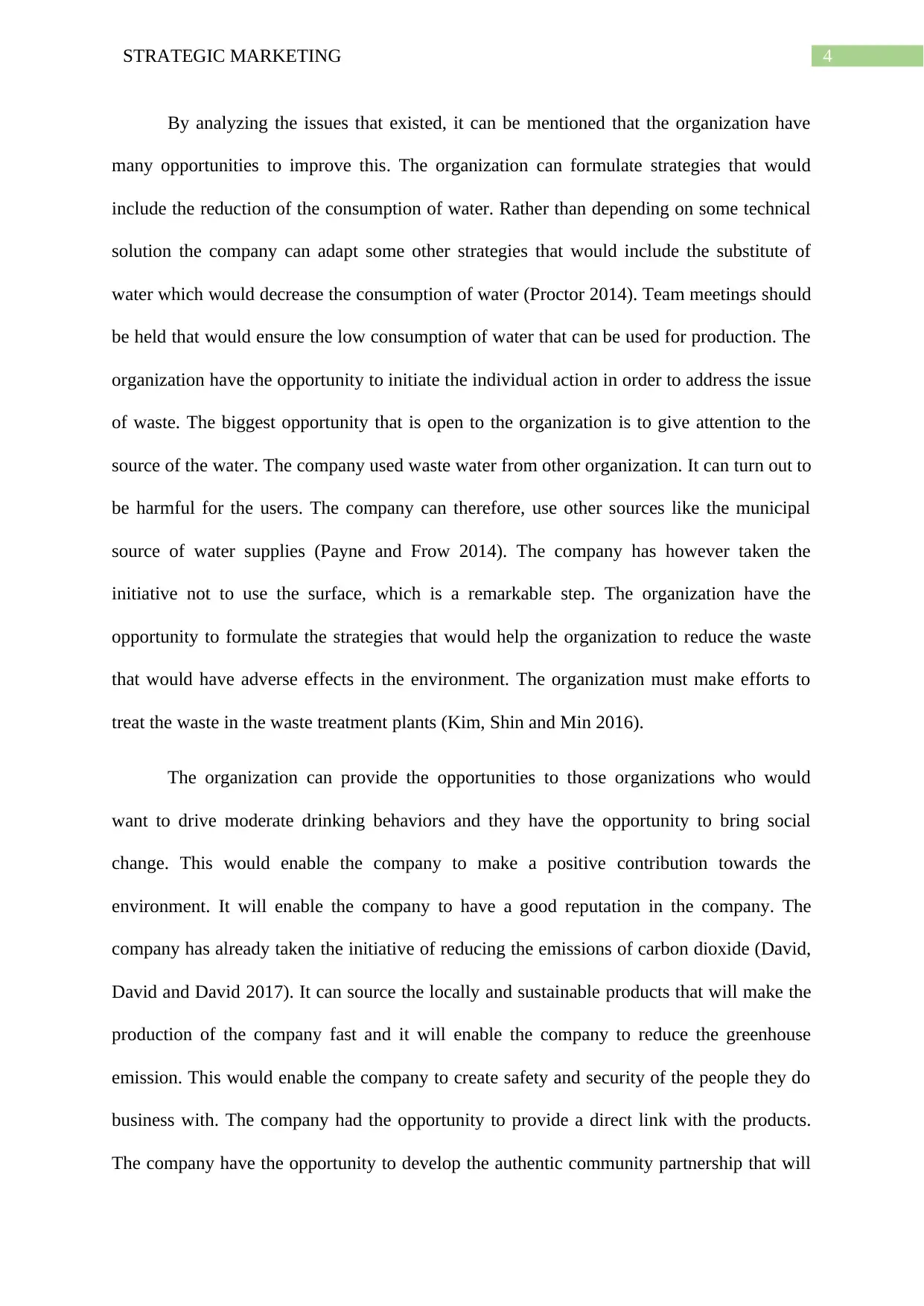
4STRATEGIC MARKETING
By analyzing the issues that existed, it can be mentioned that the organization have
many opportunities to improve this. The organization can formulate strategies that would
include the reduction of the consumption of water. Rather than depending on some technical
solution the company can adapt some other strategies that would include the substitute of
water which would decrease the consumption of water (Proctor 2014). Team meetings should
be held that would ensure the low consumption of water that can be used for production. The
organization have the opportunity to initiate the individual action in order to address the issue
of waste. The biggest opportunity that is open to the organization is to give attention to the
source of the water. The company used waste water from other organization. It can turn out to
be harmful for the users. The company can therefore, use other sources like the municipal
source of water supplies (Payne and Frow 2014). The company has however taken the
initiative not to use the surface, which is a remarkable step. The organization have the
opportunity to formulate the strategies that would help the organization to reduce the waste
that would have adverse effects in the environment. The organization must make efforts to
treat the waste in the waste treatment plants (Kim, Shin and Min 2016).
The organization can provide the opportunities to those organizations who would
want to drive moderate drinking behaviors and they have the opportunity to bring social
change. This would enable the company to make a positive contribution towards the
environment. It will enable the company to have a good reputation in the company. The
company has already taken the initiative of reducing the emissions of carbon dioxide (David,
David and David 2017). It can source the locally and sustainable products that will make the
production of the company fast and it will enable the company to reduce the greenhouse
emission. This would enable the company to create safety and security of the people they do
business with. The company had the opportunity to provide a direct link with the products.
The company have the opportunity to develop the authentic community partnership that will
By analyzing the issues that existed, it can be mentioned that the organization have
many opportunities to improve this. The organization can formulate strategies that would
include the reduction of the consumption of water. Rather than depending on some technical
solution the company can adapt some other strategies that would include the substitute of
water which would decrease the consumption of water (Proctor 2014). Team meetings should
be held that would ensure the low consumption of water that can be used for production. The
organization have the opportunity to initiate the individual action in order to address the issue
of waste. The biggest opportunity that is open to the organization is to give attention to the
source of the water. The company used waste water from other organization. It can turn out to
be harmful for the users. The company can therefore, use other sources like the municipal
source of water supplies (Payne and Frow 2014). The company has however taken the
initiative not to use the surface, which is a remarkable step. The organization have the
opportunity to formulate the strategies that would help the organization to reduce the waste
that would have adverse effects in the environment. The organization must make efforts to
treat the waste in the waste treatment plants (Kim, Shin and Min 2016).
The organization can provide the opportunities to those organizations who would
want to drive moderate drinking behaviors and they have the opportunity to bring social
change. This would enable the company to make a positive contribution towards the
environment. It will enable the company to have a good reputation in the company. The
company has already taken the initiative of reducing the emissions of carbon dioxide (David,
David and David 2017). It can source the locally and sustainable products that will make the
production of the company fast and it will enable the company to reduce the greenhouse
emission. This would enable the company to create safety and security of the people they do
business with. The company had the opportunity to provide a direct link with the products.
The company have the opportunity to develop the authentic community partnership that will
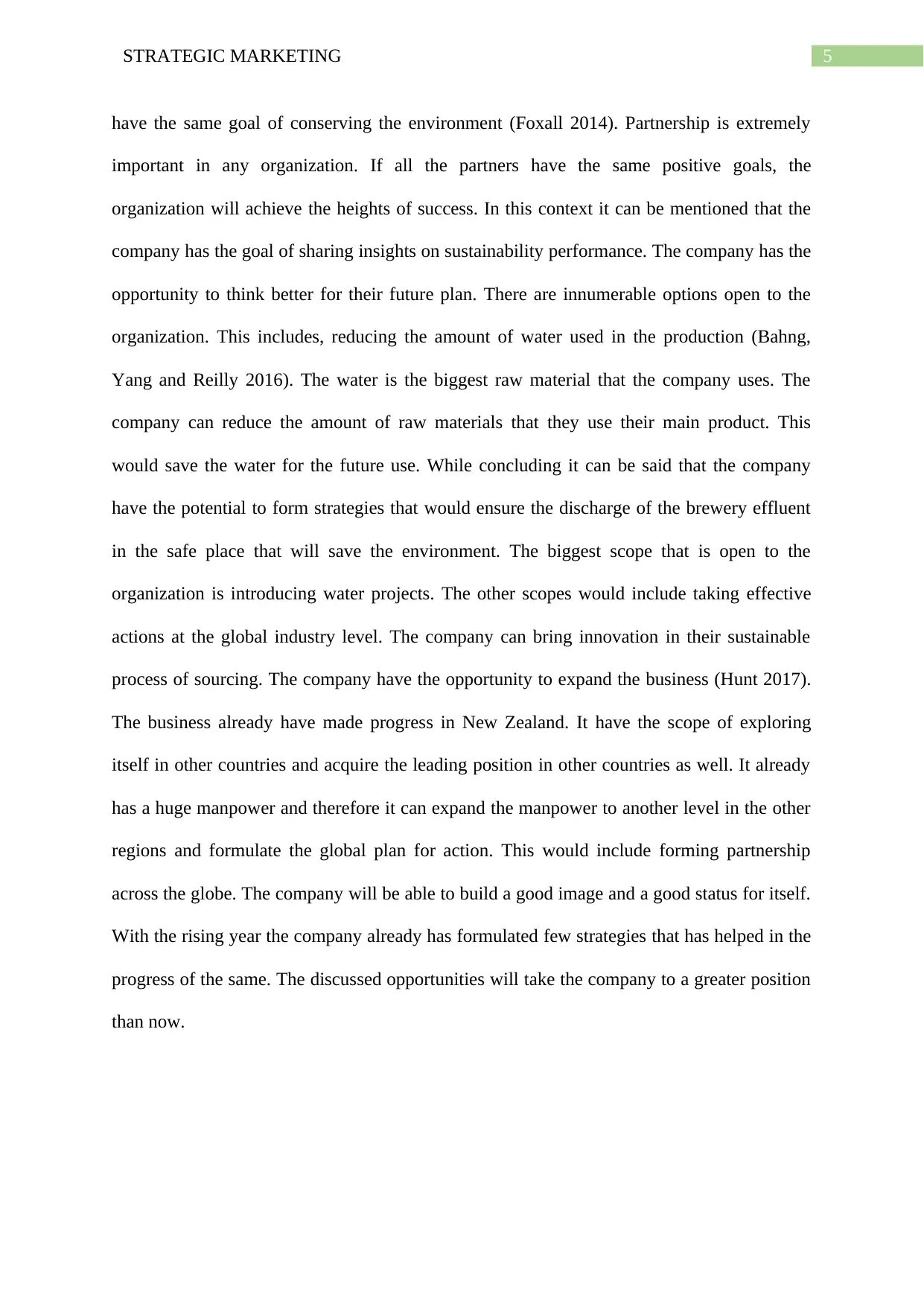
5STRATEGIC MARKETING
have the same goal of conserving the environment (Foxall 2014). Partnership is extremely
important in any organization. If all the partners have the same positive goals, the
organization will achieve the heights of success. In this context it can be mentioned that the
company has the goal of sharing insights on sustainability performance. The company has the
opportunity to think better for their future plan. There are innumerable options open to the
organization. This includes, reducing the amount of water used in the production (Bahng,
Yang and Reilly 2016). The water is the biggest raw material that the company uses. The
company can reduce the amount of raw materials that they use their main product. This
would save the water for the future use. While concluding it can be said that the company
have the potential to form strategies that would ensure the discharge of the brewery effluent
in the safe place that will save the environment. The biggest scope that is open to the
organization is introducing water projects. The other scopes would include taking effective
actions at the global industry level. The company can bring innovation in their sustainable
process of sourcing. The company have the opportunity to expand the business (Hunt 2017).
The business already have made progress in New Zealand. It have the scope of exploring
itself in other countries and acquire the leading position in other countries as well. It already
has a huge manpower and therefore it can expand the manpower to another level in the other
regions and formulate the global plan for action. This would include forming partnership
across the globe. The company will be able to build a good image and a good status for itself.
With the rising year the company already has formulated few strategies that has helped in the
progress of the same. The discussed opportunities will take the company to a greater position
than now.
have the same goal of conserving the environment (Foxall 2014). Partnership is extremely
important in any organization. If all the partners have the same positive goals, the
organization will achieve the heights of success. In this context it can be mentioned that the
company has the goal of sharing insights on sustainability performance. The company has the
opportunity to think better for their future plan. There are innumerable options open to the
organization. This includes, reducing the amount of water used in the production (Bahng,
Yang and Reilly 2016). The water is the biggest raw material that the company uses. The
company can reduce the amount of raw materials that they use their main product. This
would save the water for the future use. While concluding it can be said that the company
have the potential to form strategies that would ensure the discharge of the brewery effluent
in the safe place that will save the environment. The biggest scope that is open to the
organization is introducing water projects. The other scopes would include taking effective
actions at the global industry level. The company can bring innovation in their sustainable
process of sourcing. The company have the opportunity to expand the business (Hunt 2017).
The business already have made progress in New Zealand. It have the scope of exploring
itself in other countries and acquire the leading position in other countries as well. It already
has a huge manpower and therefore it can expand the manpower to another level in the other
regions and formulate the global plan for action. This would include forming partnership
across the globe. The company will be able to build a good image and a good status for itself.
With the rising year the company already has formulated few strategies that has helped in the
progress of the same. The discussed opportunities will take the company to a greater position
than now.
⊘ This is a preview!⊘
Do you want full access?
Subscribe today to unlock all pages.

Trusted by 1+ million students worldwide
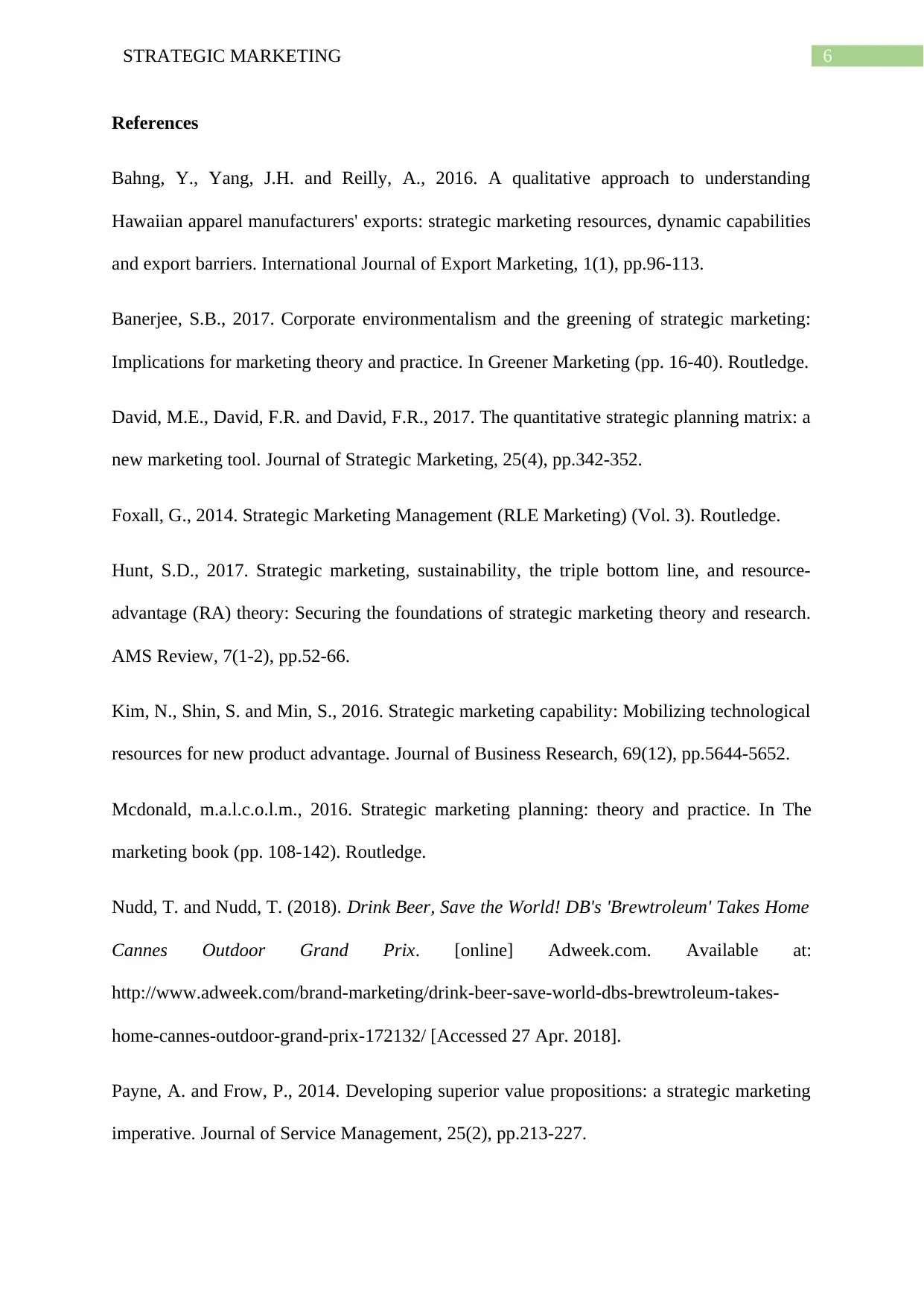
6STRATEGIC MARKETING
References
Bahng, Y., Yang, J.H. and Reilly, A., 2016. A qualitative approach to understanding
Hawaiian apparel manufacturers' exports: strategic marketing resources, dynamic capabilities
and export barriers. International Journal of Export Marketing, 1(1), pp.96-113.
Banerjee, S.B., 2017. Corporate environmentalism and the greening of strategic marketing:
Implications for marketing theory and practice. In Greener Marketing (pp. 16-40). Routledge.
David, M.E., David, F.R. and David, F.R., 2017. The quantitative strategic planning matrix: a
new marketing tool. Journal of Strategic Marketing, 25(4), pp.342-352.
Foxall, G., 2014. Strategic Marketing Management (RLE Marketing) (Vol. 3). Routledge.
Hunt, S.D., 2017. Strategic marketing, sustainability, the triple bottom line, and resource-
advantage (RA) theory: Securing the foundations of strategic marketing theory and research.
AMS Review, 7(1-2), pp.52-66.
Kim, N., Shin, S. and Min, S., 2016. Strategic marketing capability: Mobilizing technological
resources for new product advantage. Journal of Business Research, 69(12), pp.5644-5652.
Mcdonald, m.a.l.c.o.l.m., 2016. Strategic marketing planning: theory and practice. In The
marketing book (pp. 108-142). Routledge.
Nudd, T. and Nudd, T. (2018). Drink Beer, Save the World! DB's 'Brewtroleum' Takes Home
Cannes Outdoor Grand Prix. [online] Adweek.com. Available at:
http://www.adweek.com/brand-marketing/drink-beer-save-world-dbs-brewtroleum-takes-
home-cannes-outdoor-grand-prix-172132/ [Accessed 27 Apr. 2018].
Payne, A. and Frow, P., 2014. Developing superior value propositions: a strategic marketing
imperative. Journal of Service Management, 25(2), pp.213-227.
References
Bahng, Y., Yang, J.H. and Reilly, A., 2016. A qualitative approach to understanding
Hawaiian apparel manufacturers' exports: strategic marketing resources, dynamic capabilities
and export barriers. International Journal of Export Marketing, 1(1), pp.96-113.
Banerjee, S.B., 2017. Corporate environmentalism and the greening of strategic marketing:
Implications for marketing theory and practice. In Greener Marketing (pp. 16-40). Routledge.
David, M.E., David, F.R. and David, F.R., 2017. The quantitative strategic planning matrix: a
new marketing tool. Journal of Strategic Marketing, 25(4), pp.342-352.
Foxall, G., 2014. Strategic Marketing Management (RLE Marketing) (Vol. 3). Routledge.
Hunt, S.D., 2017. Strategic marketing, sustainability, the triple bottom line, and resource-
advantage (RA) theory: Securing the foundations of strategic marketing theory and research.
AMS Review, 7(1-2), pp.52-66.
Kim, N., Shin, S. and Min, S., 2016. Strategic marketing capability: Mobilizing technological
resources for new product advantage. Journal of Business Research, 69(12), pp.5644-5652.
Mcdonald, m.a.l.c.o.l.m., 2016. Strategic marketing planning: theory and practice. In The
marketing book (pp. 108-142). Routledge.
Nudd, T. and Nudd, T. (2018). Drink Beer, Save the World! DB's 'Brewtroleum' Takes Home
Cannes Outdoor Grand Prix. [online] Adweek.com. Available at:
http://www.adweek.com/brand-marketing/drink-beer-save-world-dbs-brewtroleum-takes-
home-cannes-outdoor-grand-prix-172132/ [Accessed 27 Apr. 2018].
Payne, A. and Frow, P., 2014. Developing superior value propositions: a strategic marketing
imperative. Journal of Service Management, 25(2), pp.213-227.
Paraphrase This Document
Need a fresh take? Get an instant paraphrase of this document with our AI Paraphraser
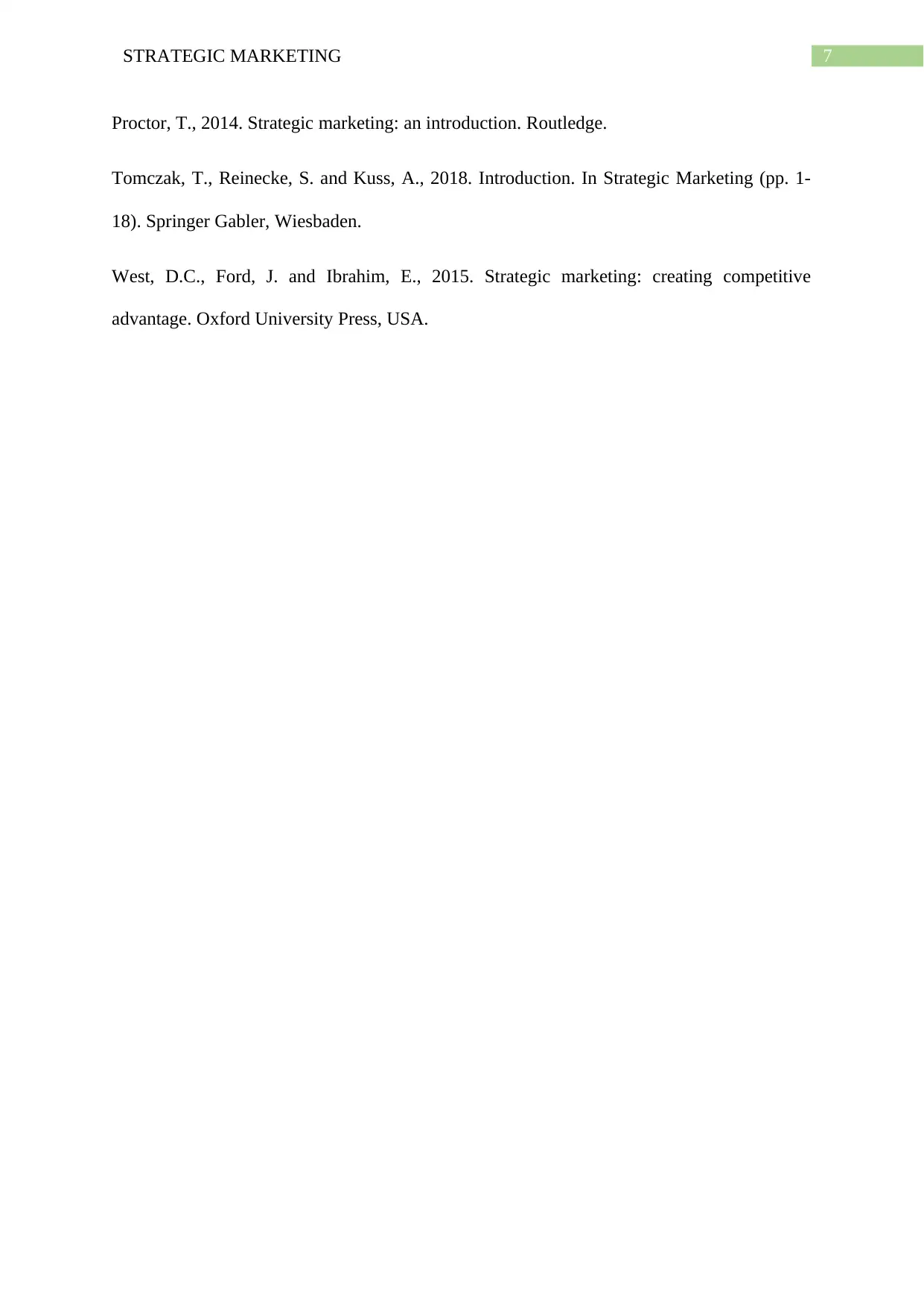
7STRATEGIC MARKETING
Proctor, T., 2014. Strategic marketing: an introduction. Routledge.
Tomczak, T., Reinecke, S. and Kuss, A., 2018. Introduction. In Strategic Marketing (pp. 1-
18). Springer Gabler, Wiesbaden.
West, D.C., Ford, J. and Ibrahim, E., 2015. Strategic marketing: creating competitive
advantage. Oxford University Press, USA.
Proctor, T., 2014. Strategic marketing: an introduction. Routledge.
Tomczak, T., Reinecke, S. and Kuss, A., 2018. Introduction. In Strategic Marketing (pp. 1-
18). Springer Gabler, Wiesbaden.
West, D.C., Ford, J. and Ibrahim, E., 2015. Strategic marketing: creating competitive
advantage. Oxford University Press, USA.
1 out of 8
Your All-in-One AI-Powered Toolkit for Academic Success.
+13062052269
info@desklib.com
Available 24*7 on WhatsApp / Email
![[object Object]](/_next/static/media/star-bottom.7253800d.svg)
Unlock your academic potential
Copyright © 2020–2025 A2Z Services. All Rights Reserved. Developed and managed by ZUCOL.